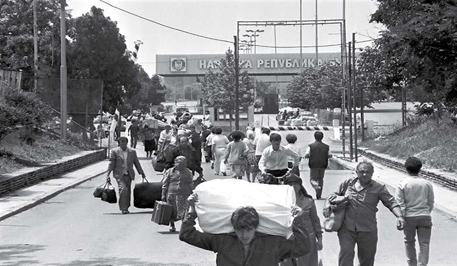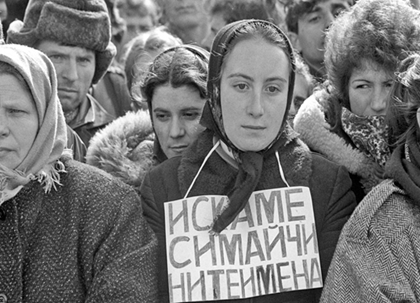
Lesson plan: “Revival Process” in Bulgaria – Part 1
August 26, 2018Estimated time required: 40-45 min/one lesson
Our pedagogical objectives
- Student analyses different sources of the so-called ‚Revival process‘ in Bulgaria which was a re-naming campaign of Bulgarian Turks as part of a process of forced assimilation by the communist regime
- Student becomes aware of forceful policy of uniformity and othering and thereby the construction of enemies
- Student becomes aware of issues of identity and belonging and their significance of the liberty to be in era of state socialism
Activity 1 – Source 1: Introductory photograph
Required time: 10 mins
Set-up: classroom

(Copyright 2013, Bursa Büyükşehir Belediyesi), the picture was taken in 1989
Discussion questions:
Let the students see the photo and use the following questions to prompt reflection and understanding of it. Take notes of the suggestions on the board in the class so that the discussion can return to the initial ideas later:
- Describe the people on the picture: what are they are doing?
- Make a hypothesis of why they are on the move: what do you think happened?
- Can you think of reasons why people move?
- Do you see any connection between the photo and some contemporary events?
- Who do you think these people might be? Do you think their life has changed since the photograph was taken?
Here students should interpret what could be the reasons people are walking on foot, carrying their luggage with them: to infer about the circumstances around the migratory movement. The emphasis is to articulate the value and meaning of belonging, the concept of home, departure and arrival.
→ Explanatory text for teachers: Although Bulgaria, unlike Albania, Romania and Yugoslavia, did not take an anti-Soviet position, since the early 1960s there were clear signs of a return to old traditional nationalism, which was primarily hostile to minorities. The communist regime in Bulgaria gradually recognized an enemy in the face of various Muslim communities and started targeted attempts to assimilate and marginalize them. From 1959-1960 onwards in the regions with mixed Muslim and Christian population many actions were taken to forcibly remove traditional Muslim clothing or separate elements of it. Thus, the regime tried to at least externally unify its subjects and erase the scars of their religion.
Activity 2 – Source 2: Second photograph – The ‚Revival process‘
Required time: 10 mins
Set-up: classroom

The sign says, “We want our mothers’ names back”
(Available at: http://reflection-eu.info/bg/content/%D1%81%D1%8A%D0%B1%D0%B8%D1%82%D0%B8%D1%8Fevents)
Discussion questions:
Allow students to look at the photo and use the following questions to prompt reflection and understanding of it.
- What are the people on the picture doing? What is the atmosphere?
- How do you understand the message?
- Why would anyone want to change somebody’s name?
- What does a name mean to us?
- What would it mean for you if your name would have been taken away (connection to identity)?
→ Explanatory text for teachers: After the Bulgarian and Roma Muslims, the policy started also targeting Bulgarian Turks. Thus, in 1972 a massive campaign to forcefully change the names of all Bulgarian Muslims started which in some places was met with serious resistance and rebellion, some of which were crushed with brutal violence, victims and dozens injured. Local intelligentsia, party members in these settlements, teachers, and others were systematically pressured to set an example by changing their names to Bulgarian ones first. In some areas the policy had more visible results but in others it almost found no followers. According to the official version of the regime there was a spontaneous ‘revival process’ of former Muslims who have realized the truth about their Bulgarian roots and have simultaneously wanted to change their names in Bulgarian. The latest and most dramatic episode of the Bulgarian Communist Party policy towards Muslim communities in the country was in 1984. Because of their resistance to the forced change of their own names, many people found themselves in jail and in forced labour camps. After changing the names of the living, a process of renaming the dead began including removal of traces of non-Bulgarian names from tombstones. This form of memory replacement of the memory of the dead and the symbolism that it contains within itself proves to be one of the most traumatic aspects of the ‘revival process’.
